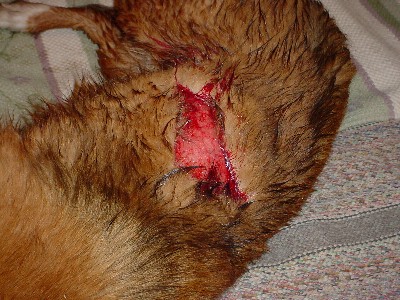Recognising different categories of wounds and bleeding
.
.
Although its not at all important for the average dog owner to know the medical terminology for the various categories of wounds and bleeds, knowing how to differentiate between the the different types of wounds will help you decide how best to dress/treat a wound. For instance with an injury caused by glass, stopping the bleeding is quite probably your priority. An injury caused by rusty barbed wire would very probably require careful cleansing as a matter of urgency.
.
Today, we’ll describe the individual categories and tomorrow, how to treat them (each is different). Dog wise, our most important skin wounds are:
.
Laceration –
A rip or tear of the skin. This type of wound is often caused by barbed wire, jagged wooden fencing or branches and sometimes during a dog fight. It is a “jagged” tear of the flesh and is more likely to have particles of dirt in it than would a clean cut. They do, however, usually bleeds less.
.
Incision –
A clean cut or slice, usually caused by a sharp object such as glass or the blade of a knife. Incisions can be a very deep and may involve complications such as severed tendons or blood vessels. This type of wound could “gape open” and bleed profusely. On the plus side, however, as they are caused by a single sharp slice they are usually much cleaner.
.
Puncture –
A stabbing/penetrating wound. This wound could result from standing on something sharp, from flesh being penetrated by a tooth/fang during a dog fight, or perhpas by being stabbed. The wound could be very deep and yet appear very small in diameter. It is important to remember that damage may be caused to underlying organs such as the heart or lungs and severe internal bleeding may occur.
.
Degloving –
This injury often occurs when a heavy, blunt object has fallen onto a limb, gauging a tear in the flesh and then because of the weight of the object, the flesh becomes pushed down and creased like a long glove being removed. The other way in which a degloving injury looks is when rather than the skin creasing dowards, the flesh forms a flap of skin which is still connected along an edge.
.
Amputation –
Amputation is partial or complete severing of a limb ie perhaps the tip of a tail has been completely removed or maybe a stopper pad for instance has been sliced through and is hanging on merely by a small piece of flesh. Even though it is still connected to the animal, this wound would be classed as an amputation.
.

